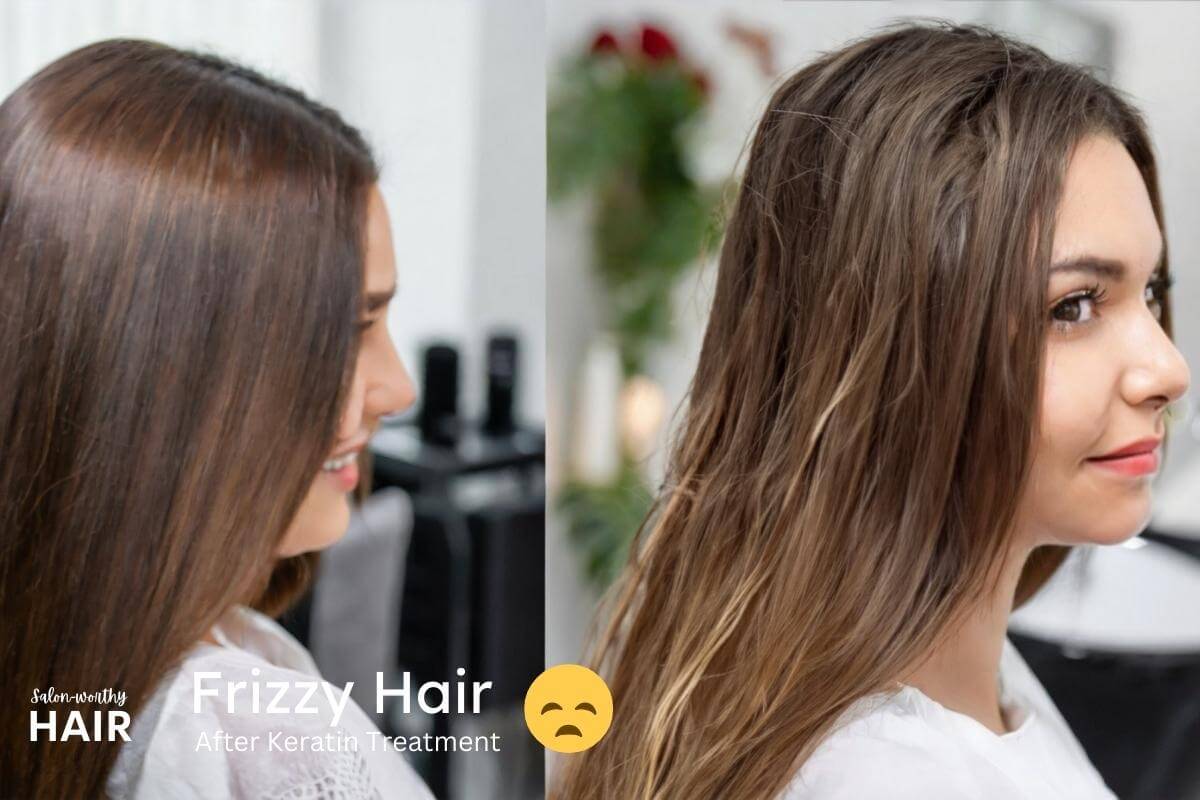Why Your Hair is Frizzy After Keratin Treatment and How to Fix It Quick
Updated on
This post may contain affiliate links. As an Amazon Associate, we may earn from qualifying purchases.

Frizz after a keratin treatment can be caused by incorrect application, product quality, the pre-existing condition of the hair, and post-treatment hair care regimen.
The effectiveness of a keratin treatment, including Brazilian hair straightening and smoothing treatment, largely depends on proper application and the quality of the product used. Product and application effectiveness include the amount used, application technique, and the treatment processing time. If the product is not applied correctly, it can result in uneven coating of the hair shaft, which may not effectively smooth the cuticle and could lead to frizz.
Instead of creating a resilient shield against humidity, the compromised application or substandard mixture can leave your hair vulnerable, resulting in a lack of smoothness and definition. The resulting frizz is especially true if the hair’s natural porosity isn’t properly addressed, permitting humidity to penetrate and puff up the strands.
Moreover, subsequent use of sulfate-based shampoos and a poorly-planned aftercare routine can erode the keratin coating on the hair prematurely, further diminishing the smooth, sleek effect that a keratin treatment typically guarantees.
After talking to a couple of hairstylists to get some answers, I’ve detailed below the reasons why your hair can revert to frizziness.
To help you further, I’ve also listed anti-frizz solutions, alternative hair cleansing options like dry shampoos, and ways to keep your hair hydrated to mitigate the frizz.
Reasons Why Hair Is Frizzy After Keratin Treatment
Here are the reasons why your hair is frizzy after a keratin treatment:

Improper Application
Improper application of a keratin treatment sets the stage for frizz. When keratin is not applied evenly, certain strands miss out on the smoothing agent, creating patches of treated and untreated areas. This inconsistency leaves gaps in the hair’s cuticle, which the keratin should seal.
These gaps behave like open doors, allowing moisture from humid air to infiltrate and swell the hair shaft, leading to that unwanted fluffy appearance. Moreover, without the uniform seal, hair becomes vulnerable to texture irregularities where some sections may appear smooth and others frizzy, disrupting the sleek look. It’s this uneven seal and protection that directly correlates with the emergence of frizz, betraying the very promise of keratin treatments.
Poor-Quality Keratin Treatment
Poor-quality keratin treatments often lack the essential ingredients that effectively smooth the hair cuticle. This deficiency fails to combat the natural tendency of hair strands to absorb atmospheric moisture. When hair is exposed to humidity, these subpar treatments provide insufficient defense, leading to cuticle lifting and hair swelling – a direct path to frizz.
Additionally, treatments of inferior quality may not adhere to the hair as intended, resulting in a shorter lifespan of the smoothing effect and a quicker reversion to a frizzy state. The inability of these treatments to seal in moisture and nutrients leaves the hair’s natural porosity unchecked, further exacerbating the frizz issue as hair fibers react variably to the environment. Thus, the frizz becomes an inevitable consequence of a keratin treatment that doesn’t meet the necessary standards for hair smoothing.
Pre-Existing Hair Damage
Existing hair damage compromises the hair’s natural defense against frizz. This damage often results in a raised cuticle layer, making hair more porous and prone to absorbing atmospheric moisture, which leads to frizz.
Damaged hair lacks the necessary proteins and natural oils that help keep the hair shaft smooth and resistant to the humidity that causes frizz. When keratin treatments are applied to damaged hair, they may not adhere as effectively or further stress the hair shaft, exacerbating the frizz instead of smoothing it out.
Therefore, the health of the hair pre-treatment is a critical factor in the fight against frizz.
Poor Aftercare Routine
Poor aftercare routine compromises the longevity and effectiveness of a keratin treatment, setting the stage for frizz. Skipping protective serums or neglecting to use sulfate-free shampoos weakens the treatment’s seal, allowing humidity to infiltrate and puff up the hair.
Inadequate hydration post-treatment can also uplift the cuticles, creating a rough texture prone to frizzing. Moreover, excessive heat styling without appropriate heat-protectant products can exacerbate hair cuticle damage, leading to a frizzy appearance. Each misstep in aftercare can gradually erode the keratin’s smoothing effects, ultimately manifesting as unruly frizz.
Solutions to Fix Frizzy Hair After Keratin Treatment
Consult Your Hairstylist
Consult your hairstylist if you’re facing frizz after a keratin treatment. As trained professionals, they can assess whether the frizz is due to application errors, such as uneven product distribution, or external factors like humidity.
They may pinpoint if your hair’s inherent porosity wasn’t properly accounted for or if post-treatment care was inadequate. Armed with this insight, your stylist can recommend tailored solutions—potentially a corrective treatment or a regimen adjustment—to realign with the keratin treatment’s intended outcome: sleek, smooth hair. Their expertise is vital to navigating back to a frizz-free state, ensuring your hair maintains the smooth texture that a keratin treatment promises.
Use Gentle Anti-Frizz Products
Gentle anti-frizz products can tame and rectify frizz following a keratin treatment.
These specialized products are designed to tame frizz without compromising the keratin treatment’s integrity. By providing necessary hydration and sealing the hair cuticle, they prevent moisture from penetrating and puffing up the hair strands. Moreover, serums and leave-in conditioners with smoothing properties can help to maintain the sleekness induced by the keratin, counteracting the effects of humidity and other frizz-inducing elements.
This targeted approach not only addresses the immediate frizzy texture but also fortifies the hair’s defense against future frizz, ensuring that the smoothing benefits of the keratin treatment are preserved and prolonged.
Recommended: Gentle anti-frizz hair products.
Use Dry Shampoo to Reduce Hair Washing Frequency
Use of dry shampoo can extend the life of a keratin treatment by reducing the need for frequent hair washes. Water can swell the hair shaft, and shampoos, especially those containing sulfates, can strip hair of its protective keratin layer.
By absorbing excess oil and dirt, dry shampoo freshens the hair while minimizing exposure to water and harsh chemicals that can contribute to frizz. This way, the smoothing effects of the keratin treatment are maintained, effectively combating frizz and keeping hair sleek longer between washes.
Use Heat Protectant and Low Heat When Heat Styling
Using a heat protectant and low heat, ideally below 149°C to 177°C (300°F to 350°F), during styling is crucial for maintaining the integrity of a keratin treatment.
Heat protectant forms a barrier, minimizing heat damage and preserving the keratin layer that keeps hair smooth. Low heat settings ensure that the hair’s cuticle remains flat and sealed, preventing moisture from seeping in and causing frizz.
By adopting these measures, you sustain the keratin’s smoothing effects, thereby effectively combating post-treatment frizz and maintaining sleek, polished locks.
Keep Your Hair Hydrated
Adequate moisture ensures the hair cuticle remains smooth and sealed, preventing the penetration of external moisture that leads to frizz.
To maintain hydration, use sulfate-free shampoos and conditioners to complement keratin treatments, locking in moisture without stripping away the protective proteins.
Incorporating leave-in conditioners or serums rich in natural oils can also aid in keeping the hair fiber nourished and pliable, reducing the likelihood of the hair shaft swelling with humidity. This consistent hydration regimen not only combats existing frizz but acts as a preventative measure, fortifying the hair against future frizz-inducing conditions.
Tame the Frizz and Preserve Your Keratin Treatment Results
Frizzy hair after a keratin treatment can occur due to various factors, such as improper product application, use of low-quality keratin products, pre-existing hair damage, and a poor aftercare routine. An uneven application leaves parts of the hair untreated, allowing humidity to cause frizz.
To fix the frizziness, consult a hairstylist to understand the root cause and adjust your care routine accordingly. Using gentle anti-frizz products that hydrate and seal the cuticle can help maintain the treatment’s effects and manage frizz. Reducing hair washing frequency with dry shampoo avoids keratin stripping, and using a heat protectant with low heat settings during styling prevents damage to the keratin layer.
Keeping your hair hydrated with suitable products ensures the cuticle stays sealed, which is crucial for preventing frizz and maintaining the treatment’s benefits.
About the Author
 Camelia Smith
Camelia SmithCamelia Smith can color hair, perform keratin treatments, bleach hair, and even cut curly hair. She is our go-to person whenever we have hair treatments and styling questions.
She's also currently training as a freelance makeup artist and is passionate about helping others feel beautiful in their skin. When she's not writing or doing hair, she's usually spending time watching British period dramas.